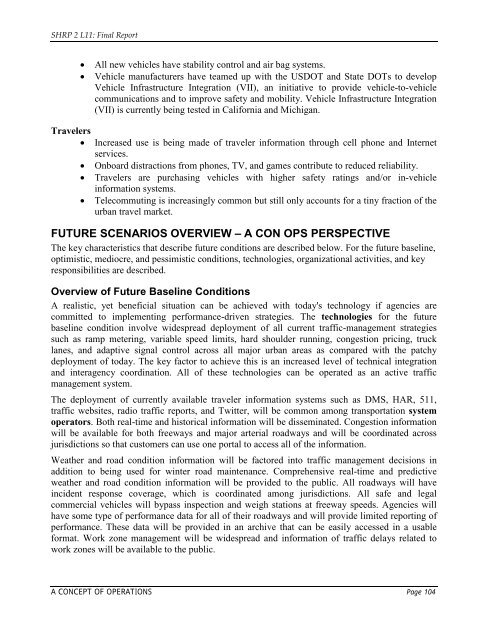Evaluating Alternative Operations Strategies to Improve Travel Time ...
Evaluating Alternative Operations Strategies to Improve Travel Time ...
Evaluating Alternative Operations Strategies to Improve Travel Time ...
You also want an ePaper? Increase the reach of your titles
YUMPU automatically turns print PDFs into web optimized ePapers that Google loves.
SHRP 2 L11: Final Report<br />
• All new vehicles have stability control and air bag systems.<br />
• Vehicle manufacturers have teamed up with the USDOT and State DOTs <strong>to</strong> develop<br />
Vehicle Infrastructure Integration (VII), an initiative <strong>to</strong> provide vehicle-<strong>to</strong>-vehicle<br />
communications and <strong>to</strong> improve safety and mobility. Vehicle Infrastructure Integration<br />
(VII) is currently being tested in California and Michigan.<br />
<strong>Travel</strong>ers<br />
• Increased use is being made of traveler information through cell phone and Internet<br />
services.<br />
• Onboard distractions from phones, TV, and games contribute <strong>to</strong> reduced reliability.<br />
• <strong>Travel</strong>ers are purchasing vehicles with higher safety ratings and/or in-vehicle<br />
information systems.<br />
• Telecommuting is increasingly common but still only accounts for a tiny fraction of the<br />
urban travel market.<br />
FUTURE SCENARIOS OVERVIEW – A CON OPS PERSPECTIVE<br />
The key characteristics that describe future conditions are described below. For the future baseline,<br />
optimistic, mediocre, and pessimistic conditions, technologies, organizational activities, and key<br />
responsibilities are described.<br />
Overview of Future Baseline Conditions<br />
A realistic, yet beneficial situation can be achieved with <strong>to</strong>day's technology if agencies are<br />
committed <strong>to</strong> implementing performance-driven strategies. The technologies for the future<br />
baseline condition involve widespread deployment of all current traffic-management strategies<br />
such as ramp metering, variable speed limits, hard shoulder running, congestion pricing, truck<br />
lanes, and adaptive signal control across all major urban areas as compared with the patchy<br />
deployment of <strong>to</strong>day. The key fac<strong>to</strong>r <strong>to</strong> achieve this is an increased level of technical integration<br />
and interagency coordination. All of these technologies can be operated as an active traffic<br />
management system.<br />
The deployment of currently available traveler information systems such as DMS, HAR, 511,<br />
traffic websites, radio traffic reports, and Twitter, will be common among transportation system<br />
opera<strong>to</strong>rs. Both real-time and his<strong>to</strong>rical information will be disseminated. Congestion information<br />
will be available for both freeways and major arterial roadways and will be coordinated across<br />
jurisdictions so that cus<strong>to</strong>mers can use one portal <strong>to</strong> access all of the information.<br />
Weather and road condition information will be fac<strong>to</strong>red in<strong>to</strong> traffic management decisions in<br />
addition <strong>to</strong> being used for winter road maintenance. Comprehensive real-time and predictive<br />
weather and road condition information will be provided <strong>to</strong> the public. All roadways will have<br />
incident response coverage, which is coordinated among jurisdictions. All safe and legal<br />
commercial vehicles will bypass inspection and weigh stations at freeway speeds. Agencies will<br />
have some type of performance data for all of their roadways and will provide limited reporting of<br />
performance. These data will be provided in an archive that can be easily accessed in a usable<br />
format. Work zone management will be widespread and information of traffic delays related <strong>to</strong><br />
work zones will be available <strong>to</strong> the public.<br />
A CONCEPT OF OPERATIONS Page 104















